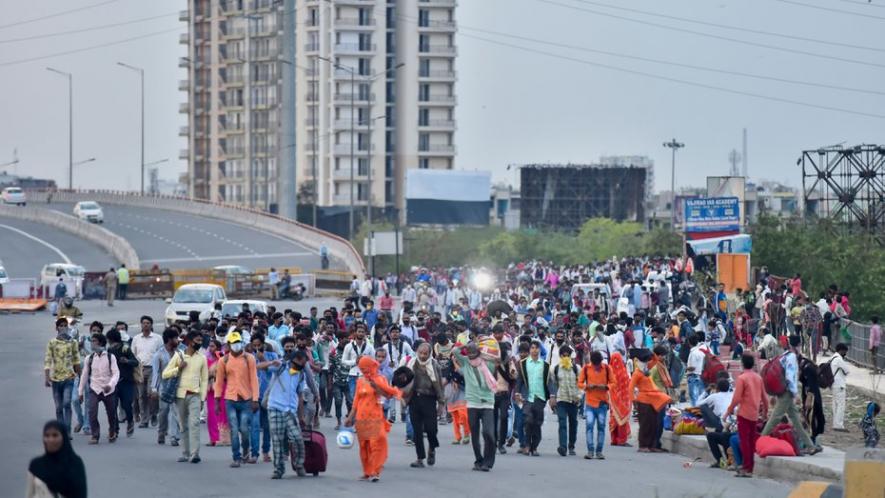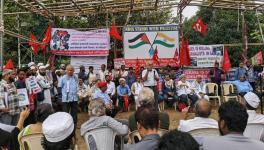Sudden Lockdown and Unfolding of an Immense Tragedy

The tragic irony could not have been more complete. The country is under lockdown, but last week thousands of migrant workers were thronging bus stands or marching on the roads, making a mockery of it; the aim of the lockdown is to prevent the spread of the pandemic, but the mass exodus can now carry the virus to the hitherto-unaffected rural India where the healthcare system is pathetic; the idea is to prevent a virus-caused human tragedy, but an immense human tragedy is now unfolding.
This is something that happens when measures are taken without proper planning and adequate preparation, as the lockdown at four hours’ notice was. Had there been proper planning, then comprehensive relief measures could have been announced along with the announcement of the lockdown itself, preventing panic.
Among these measures should have been one putting a moratorium on eviction of tenants during the lockdown, and a delivery mechanism, hitherto non-existent for millions of workers, for reaching relief to them. None of this was done; the evictions, the panic and the exodus started, and when the finance minister announced some measures two days later, they were paltry beyond belief.
The relief package of Rs 1.7 lakh crore that Sitharaman announced is not all new government expenditure; it is to a significant extent either a repackaging of expenditure that would have been undertaken anyway, or expenditure that simply cannot be undertaken at present but is still shown as relief expenditure, or expenditure from resources that belong to the workers themselves but is now being shown as part of the packagea.
The Rs 2,000 per farmer promised to be paid immediately to 8.69 crore farmers under the PM Kisan scheme, for instance, is due anyway in early April and has already figured in the budget; it is now simply being included in the package, and even the payment will be made only in early-April when it is due, rather than immediately, as claimed by the FM. Ironically, despite the fact that expenditure under the scheme over the last two years has been Rs 40,000 crore less than what was budgeted, there is no increase over the Rs 2,000 limit promised way back in the 2018-19 budget.
Likewise, the claim that MGNREGS (the rural job guarantee scheme) wages have been raised to Rs 202 per day from Rs 182 earlier and that this would provide Rs 2,000 extra to each worker is a vacuous one for multiple reasons. First, it assumes that each job-card holder gets 100 days’ employment, which is patently untrue. (Last year less than 7% of workers got 100 days of work).
Second, the ministry of rural development, which notifies wage increases annually to compensate for inflation, had already notified much higher wages for 2020-21: Rs 226 as the unweighted average and Rs 221 as the weighted average for states (weights being total MGNREGS employment); in fact most states (29 of them) already pay wages higher than Rs 202.
Third, since MGNREGS work has come to a standstill in several states because of the lockdown, the workers would not get any benefits anyway. Ironically, the FM in her speech made no mention of paying the huge wage arrears to MGNREGS workers amounting to thousands of crores.
In the last category, resources that rightfully belong to the workers and are now being shown as part of the package, there is the construction workers’ welfare fund and the mineral fund for health policy. In both these funds, arrears of spending have got built up and they are now being shown as part of the relief package without any extra claim on the budget. But, over what period this money will be spent and in what manner remains unclear.
What is more, the registered construction workers, on whom alone this money can be spent, are only a fraction (just over a half perhaps) of the total number of construction workers. So, a large segment of construction workers, who are among the most vulnerable to the lockdown, will be left untouched. In any case, the provisions under these heads are simply numbers in the absence of any concrete proposals about how and when they are going to be used.
The three areas where there is the promise of new expenditure (ignoring minuscule sums here and there) are: cash payments to the elderly and to women under the Jan Dhan Yojana; free gas cylinders under the Ujjwala scheme; and larger grain distribution under the PDS (public distribution system). These three together amount to just over half the total provision of Rs1.7 lakh crore.
Women under the Jan Dhan Yojana are to be paid Rs 500 per month, aged widows Rs 1,000 per month, and pensioners Rs1,000 per month, for three months. The amounts provided under these heads are trivial, which comes out clearly when we compare them to suggestions made by many.
Numerous organisations, intellectuals, and economists have been asking for the payment of Rs 7,000 per household to about 80% of the country’s total households (32.71 crore) for two months, over and above other forms of assistance, to tide over this crisis. This sum alone would come to Rs 3.66 lakh crore for the two-month period. The additional cash transfers provided by the FM in her package amount to Rs 34,000 crores, less than 10% of this sum! Likewise, the free cylinders will be made available only to those covered by the Ujjwala Yojana, which does not cover the entire population and would leave out many.
The proposal to provide free ration of 5 kg of wheat or rice per person per month and 1 kg of pulses per household per month through the PDS to the entire population covered under the National Food Security Act, which would cost Rs 45,000 crore, is perhaps the most noteworthy of the measures announced by the FM. There are, however, two basic flaws in this scheme: first, the entire population of 80 crore under the NFSA does not have access to the PDS, and this is certainly true of migrant labourers who live far away from their villages and families. Second, during the period of the lockdown, even getting ration becomes a problem.
In fact, these two problems afflict the entire package announced by the FM quite apart from its meagreness, namely, the problem of the migrant labourers, and the problem of delivery. These are extremely serious problems. There are, in India, around 14 crore labourers who work away from their homes, of whom around 1 crore consist of people who work in states other than their own. These are no small numbers; and the people thronging the bus stations or trekking back to their villages belong to this category. The government’s package has nothing for them. And even for others who have not left their homes, with many rations shops shut due to the lockdown, and the police beating up people who venture out of homes even for buying rations, the promise of free extra ration means little, at least as long as the lockdown lasts.
This is why many organisations have been demanding doorstep delivery during the period of lockdown, as had happened in China. By not setting up any mechanism for this and yet announcing a lockdown with four hours’ notice, the Narendra Modi government has almost made sure that even its free ration scheme will not reach the neediest.
With the Centre being both niggardly and thoughtless in the matter of relief, it will now require the state governments and the many organisations concerned with the welfare of workers and peasants, to take care of them, if a catastrophe is to be averted. But the state governments are desperately short of funds.
Tackling the pandemic at the level of the state government would require not only flexibility with regard to the FRBM (Fiscal Responsibility and Budget Management) Act, but also frontloading of the expenditure, and hence borrowing, by the state governments.
The borrowing limits by the states should, therefore, be doubled in the current year to tackle the pandemic. Not all the additional borrowing limit will necessarily get used in the current year. Besides, given the recession into which the world economy, and with it India, is slipping at present, thanks also to the contribution of COVID-19, the extra expenditure will hardly be deleterious for the economy.
Get the latest reports & analysis with people's perspective on Protests, movements & deep analytical videos, discussions of the current affairs in your Telegram app. Subscribe to NewsClick's Telegram channel & get Real-Time updates on stories, as they get published on our website.
























